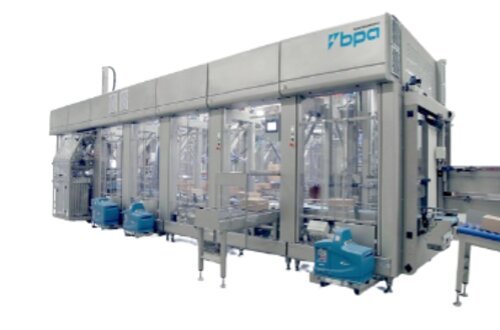AUTOMATIC TRAY PACKING MACHINE
Automatic tray packing machines are machines that apply plastic film lids to trays of varied sizes. Tray-lidding machines, heat sealers, and top sealers are all terms for automatic tray packing machines. Top Seal is the best packaging option for a range of applications, including industrial fasteners, fresh fruit, meat, frozen meals, and ready-made meals, due to its adaptability.
Food and beverage companies recognize the importance of packaging in keeping food fresh, ensuring it is readily transportable, and enticing customers. However, with so many various food packaging solutions on the market, it's easy to become confused about all of the lingo and alternatives. The use of an Automatic tray packing machine reduces manufacturing costs. A food sealer machine will pay for itself over time as the amount of time spent sealing each meal decreases.
It is not uncommon for workers to turn out sealed meals in a fifth of the time it took them to seal the trays manually following only a few minutes of training on an Automatic tray packing machine. In reality, workers' involvement is reduced to just closing the tray drawer and then opening it to take the sealed meal.
Meals packed on a tray limit the possibility of cross-contamination, both in the manufacturing area and on the shelf, making an automatic tray packing machine more hygienic. Tamper-evident trays are sealed. By formalizing your sealing process using a tray sealing machine, you will be able to seal your trays more effectively and professionally. You also eliminate issues such as an improper seal that might occur when a tray is manually sealed.
An Automatic tray packing machine saves room If you need a solution that won't take up much space in your establishment, our tiny machines are intended to fit on a countertop and take up no floor space at all. Automatic tray packing machines can provide your service with the ideal level of automation and professionalism As your company expands, your production level may be better suited for a more automated approach. Our larger machines are incredibly efficient, but they are also entirely automated.
When you use an Automatic tray packing machine, you receive the benefit of a properly positioned seal without sacrificing the uniqueness of the meals you prepare for your customers. Packing Trays Automatically Sealing and vacuum features are included in the Automatic tray packing machine.
It has a temperature controller that is sophisticated and has a robust sealing function. The use of pneumatic components simplifies the mechanical construction and reduces the likelihood of failure. The machine's functioning is more consistent and secure. The equipment may be utilized with both plastic and aluminium film rolls and is commonly employed in the beverage, milk, and food sectors.
How Does an Automatic Tray Packing Machine Operate
All procedures are entirely automated when the filled trays are placed and the vacuum chamber is closed. An automatic tray packing machine closed front protects the film and die set behind the door (no dust, filth, or contamination) while also allowing for a smooth, comprehensive all-around cleaning.
All sealable, pre-fabricated trays may be processed by these small devices. The particularly enlarged chamber accommodates a wide range of tray types and tray combinations. To save even more time, the high level of serviceability guarantees that the sealing die sets and formats may be rapidly and simply replaced without the use of any extra tools.
When changing an arrangement, a guided step-by-step instruction may be selected on the screen to guarantee that the modification is done accurately and effectively. Furthermore, the film is changed in a matter of seconds thanks to the simple-to-remove bolt. Trays with products are indexed and spaced as they enter the in-feed conveyor. A transfer beam then picks them up and transfers them within the tooling.
The seal plate then picks up the product-filled trays and lifts them against the film. The film and trays are subsequently squeezed against the heated top tooling, which activates the sealing characteristics against the tray while cutting the film. Finally, once the seal dwell time has passed, the seal station lowers the trays again, and the transfer ejects to the machine's outfeed on the following cycle.
Once the machine is turned on, the operator does not need to contact it again, reducing the possibility of cross-contamination. Simply placing the full tray on the machine initiates the sealing cycle. The tray is fed into the machine, where a film is applied to the top of the tray and the excess film is clipped. The drawer automatically opens, and the machine raises and exposes the sealed tray for removal; the entire operation takes only a few seconds.
An Automatic tray packing machine is controlled by the operator via an easy-to-use colour touch screen with a graphical interface. The display offers operational statistics and status, as well as packaging and process information. This enables more production transparency and quality control, which ensures the machine's and product's dependability. After the trays are manually or automatically put on the infeed belt, they are conveyed to the filling area and can be filled with the Aero mechanical conveyor. The capacity to adjust to varied tray or product sizes with little downtime and effort is the major advantage of using an automatic tray packing machine.
Automatic tray packing machines are constantly updated to reflect global packaging trends and are capable of processing all sealable tray and film materials available. Automatic tray packing machines are appealing due to their excellent adaptability to particular requirements. The automated tray packing machine is the right option for low-cost, professional vacuum packaging with trays, combining the convenience of use with dependability. They are perfect as an entrance machine into tray packing for small firms or as an addition to bigger operations or laboratories to cover samplings and new product launches.
Features Of Automatic Tray Packing Machine
Automatic tray packing machines provide all-around versatile solutions, whether as a stand-alone model or as part of a fully automated and (nearly) operator-free packaging line. The technical specifications outperform related machine types: Our standards, which are equipped with servo-controlled gripper arms and a knee lever mechanism, set the standard for precision tray transfer.
The Automatic tray packing machine can be easily integrated into any production process; for example, if automated dosing or labelling systems are retrofitted, the conveyor belts can be individually adapted to the grade of automatization, and whether long or short conveyor belts are required - the tray sealer can be easily upgraded over time.
The Automatic tray packing machine needs little user interaction. In most cases, operators merely need to refill packaging components by loading supply hoppers or removing completed cartons. One of the primary distinctions between a semi-automatic and completely automatic tray packing machine is that fully automatic sealers shut all flaps before taping, including the leading, trailing, and side flaps, whereas semi-automatic sealers tape just the top and bottom.
Automatic tray packing machines can cover trays of various sizes, materials, and depths with plastic film covers. An automatic tray packing machine is the ideal option for a wide range of packaging applications, including fresh fruit, meat, frozen and ready-made meals, and so much more, thanks to its adaptability.
Our Principal
Blueprint Automation, in association with Kiron Food Processing Technologies, offers a fully Automatic tray packaging solution for your business. Blueprint automation creates flexible and other difficult-to-handle packaging solutions such as daypacks, pillow bags, and four-sided sealed bags by designing, developing, and manufacturing case packing solutions.
These systems have a worldwide reputation for rapid change-over, flexibility, speed, and intelligible design, and are designed for 24-hour operation. Gravity, pick and place, wrap-around, and vision-guided robots are among the integrated state-of-the-art technologies.








